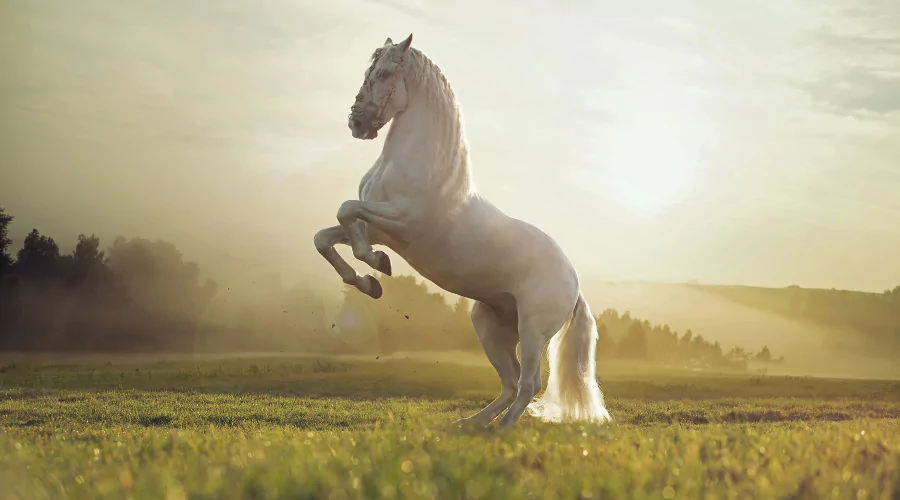France is in the heart of Europe, famed for its rich culture and history and extraordinary equestrian tradition. France has various horse breeds that stand out for their beauty, flexibility, and strength. From the elegant procession of the “horses from France” in dressage contests to the powerhouses that characterize “French draft horse breeds,” the equestrian history of this nation is as vivid as it is lasting. Whether you’re an equestrian enthusiast or just an admirer of nature’s best animals, the “horses of France” provide a fascinating trip through breeds that are as distinctive as they are wonderful.
Continuing from the great respect of France’s equestrian scenery, the country’s passion for horses pervades every area, affecting agricultural techniques, the military, and the sports world. Among the most notable breeds is the Camargue, endemic to the marshlands of the Rhône River delta. These rough horses embody the raw essence of France, still existing with minimum human influence. Then there’s the exquisite Selle Français, a breed noted for its agility and elegance in show jumping circuits globe.
History of French Horse Breeds
Historically, horses were vital to French society, impacting agriculture, the military, and transportation. The beautiful Percheron draft horse, rooted in the Huisne River valley, is a good example of power and flexibility, formerly a warhorse now regularly seen in parades and pulling carriages. France’s devotion to maintaining these breeds is seen in regulated breeding programs and national stud farms, such as the famous Haras Nationaux.
The present usage of French horse breeds stretches beyond traditional boundaries. Innovations in equestrian sports, equine-assisted treatment, and ecological farming underline their relevance in modern society. As we dive into each breed’s traits, usage, and conservation efforts, we will expose how France preserves and advances its equine history. This voyage through the ‘horses of France’ is a monument to the nation’s ongoing affinity with these wonderful creatures.
Please stay tuned as we investigate each species in depth, giving insight into the reasons for their renown and the conservation problems they confront. We will unearth the affection and respect for these great creatures ingrained in French society’s fabric.
Top 10 Rarest French Horse Breeds
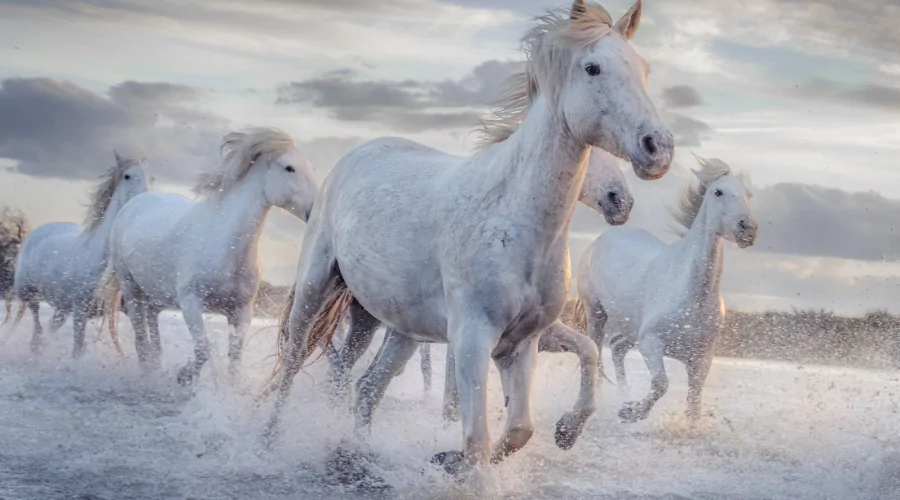
Camargue Horse
Often referred to as the “horse of the sea,” the Camargue Horse hails from the marshes of Southern France horse breeds and is one of the oldest breeds in the world. These little, rough horses are recognized for their endurance, agility, and ability to adapt to the marshes of the Rhône delta.
Renowned for its unique white coat, the Camargue Horse roams semi-feral in the Camargue area, a natural treasure France has painstakingly maintained. This breed’s historical importance is commemorated yearly in the ceremony of Abrivado, when young horses are herded through village streets, showing the common legacy between the horses and the inhabitants of the Camargue.

Selle Français
The Selle Français is famous for its skill in show jumping and dressage. This French horse breed results from mixing local French mares with thoroughbred stallions, generating an athletic and adaptable horse appreciated throughout the competitive equestrian world. The Selle Français is also recognized for its calm and intelligent disposition, making it a great companion in equine-assisted therapy programs.
The Selle Français has contributed greatly to the status of French horses in international competitions. With an outstanding ancestry that incorporates the greatest features of both worlds, their beautiful movements and muscular physique make them regular candidates for Olympic gold. This blend of quickness and brains makes the Selle Français a premier example of equestrian brilliance emerging from France.

Percheron
The Percheron is a strong draft horse with a sweet attitude. Hailing from the Perche Valley area, it was formerly deployed in combat but is now adored in performances and for pulling carriages owing to its outstanding size and power.
The stately Percheron has a complex history in battle and labor, giving it an unequaled emblem of French power and perseverance. Initially designed for combat, this breed’s powerful body and peaceful disposition proved helpful during strife. However, as the ages passed and the significance of horses in the military reduced, the Percheron effortlessly adapted to civilian life, exhibiting its adaptability and vitality. Today, these gentle giants adorn rural farmlands and urban avenues equally, marking a connection between France’s historical past and its present-day cultural festivals. Their particular blend of strength and placidity has kept the Percheron’s tradition as an equestrian jewel within the fabric of French heritage.
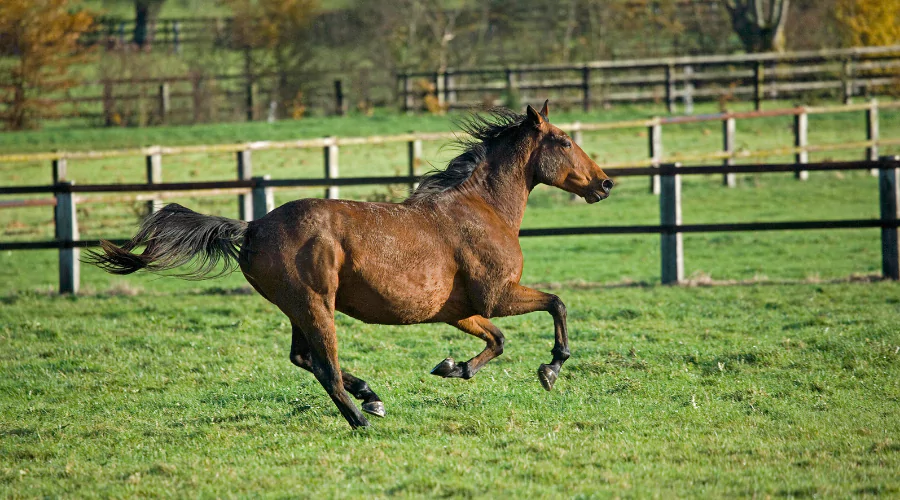
French Trotter
Known for their endurance and speed, French Trotters excel in harness racing and are typically utilized in long-distance trotting contests. This breed is a blend of Norman mares with thoroughbred heritage, showcasing their propensity for performance.
The French Trotter endures as a tribute to the country’s longstanding affection for competitive equestrian activities. Cultivated in northern France, this breed’s tenacity and endurance span endless kilometers of track, distinguishing it in trotting contests. Known as “trotters français” in their country, they are bred to produce a quick, sustainable trot — a gait defined by diagonal leg pairs working in tandem without the horse bursting into a gallop. They are frequently darker-coated horses, famed for their toughness and stamina, capable of sustaining a steady trot over long distances, which is necessary for the sports they dominate.
Their exceptional qualities on the racing track may be primarily attributable to their mixed origin. The strength of the native Norman horses, when mixed with the speed of thoroughbreds, has developed a unique breed capable of amazing athletic exploits. Beyond the thrill of racing, French Trotters are also noted for their flexibility. They commonly turn into riding horses after their trotting careers, showcasing the breed’s adaptability and equine intelligence.
As a symbol of France’s devotion to equestrian excellence, the breeding of the French Trotter is supervised by strong rules and processes, assuring the ongoing quality and potential of this outstanding breed.

Norman Cob
The strong and resilient Norman Cob has been a mainstay in French agricultural operations, noted for its capacity to adapt to diverse terrain. It’s now widely seen in riding schools and for leisure riding due to its calm temperament and power.
The Norman Cob, sturdy and trustworthy, is a versatile horse breed with deep origins in the agricultural life of Normandy. Historically, these equines were the farmer’s friend, appreciated for their power in hauling plows and carts and their endurance in working the fields from dawn until sunset. Over time, as automation gained hold, the Norman Cob found new duties to play, proving their versatility.
Today, they are typically regarded in a more recreational perspective, delivering both pleasant and safe rides because of their steady stride and even temperament. Riding schools choose the Norman Cob for training novice equestrians since their forgiving character instills beginners’ confidence and provides a pleasant learning environment. Moreover, their sturdy structure makes them acceptable mounts for various riders, ensuring that they remain a favorite option for people wanting a trustworthy and flexible horse for pleasure and sport.

Boulonnais
The exquisite Boulonnais, commonly known as the “White Marble Horse,” is a draft breed recognized for its elegance and strength, admired for its skills in pulling big loads, and its rapid, energetic trot while preserving grace.
Once employed to convey the catch from the fishing ports of the English Channel to Paris, the Boulonnais is a rarer sight, confronting problems of dwindling numbers. However, their presence remains a symbol of lasting beauty and power in the equestrian world. With a heritage that extends back to the Crusades, the breed has absorbed numerous bloodlines, including those of Arabian horses, adding to its polished stature and lively disposition.
The agility of the Boulonnais is extraordinary for a horse of its size, showing an uncommon blend of force and elegance. They boast a particular elegance, exemplified by their sleek lines and muscular definition, complementing their generally pearl-white coat, resulting in the breed’s lyrical appellation. Farmers and merchants have long depended on these equines for the most difficult duties, needing endurance and the ability to move rapidly and nimbly despite large weights.
Conservation initiatives currently play a key role in conserving the Boulonnais breed. Enthusiasts and breeders are devoted to conserving the lineage and tradition of these wonderful horses, pushing for their ongoing recognition not just as symbols of history but also as modern ambassadors of the draft horse’s eternal elegance and usefulness.
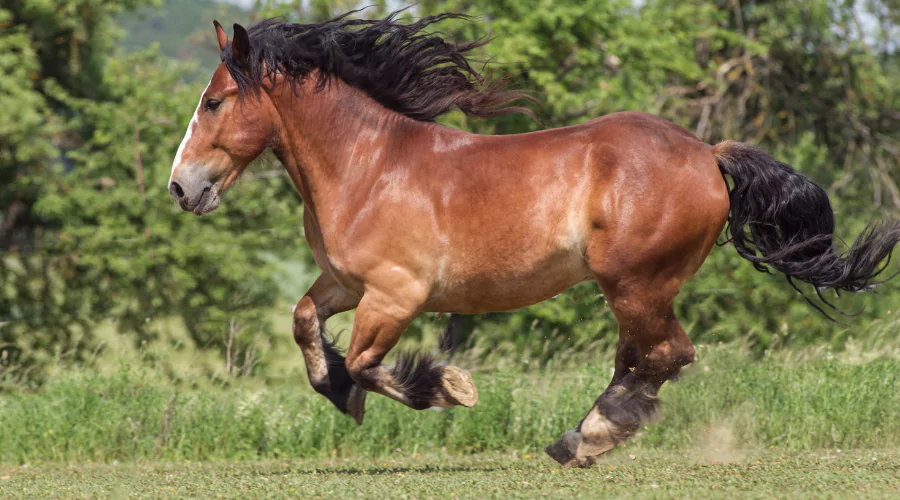
Breton Horse
Originating from Brittany, the Breton Horse is a versatile breed utilized for agricultural labor, draft uses, and meat production. They are known for their durability and aptitude for heavy tugging, making them useful in agricultural activities.
The Breton Horse is a breed rooted in a legacy of strength and endurance, built to resist the rough environments of Brittany while undertaking labor-intensive jobs. Their great pulling strength made them vital on the area’s small-scale farms, whether for tilling fields or moving commodities. Unyielding and resolute, these horses are not only workhorses; they possess a well-muscled conformation and a usually chestnut-colored coat that accentuates their physical strength.
In addition to its draft qualities, the Breton has long been prized for contributing to the region’s economy via meat production. This practice highlights the diverse role horses play in numerous cultures. The breed’s docility and manageable stature, with a powerful and compact physique, make it well-suited for farm life and trustworthy companions for people who work the land.
Today, the Breton is typically part of breeding programs that increase its qualities for draft and agricultural labor. Their versatility enables them to engage in additional activities outside agriculture, including ceremonial pulling, displaying, and even as mounts for recreational riding, demonstrating the breed’s multifunctionality and flexibility to changing social demands. Breeding groups and horse lovers are increasingly realizing the need to conserve the genetic variety and tradition of the Breton Horse, making efforts to protect and promote this characteristic breed of Brittany.
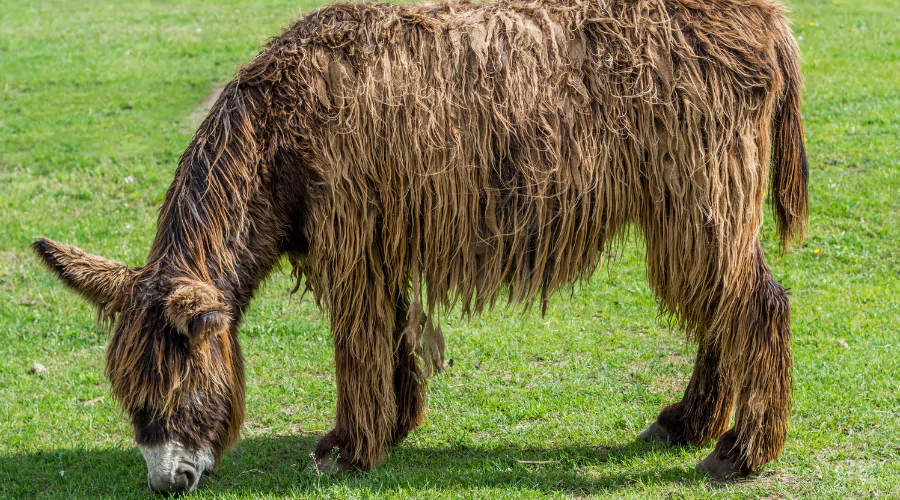
Poitou Donkey
While not a horse, the Poitou Donkey is essential to France’s equine family. With its unusual shaggy coat and huge stature, it’s employed in manufacturing mules and as part of conservation efforts owing to its rarity.
The Poitou Donkey, with its unique look and enormous size, is a breed profoundly steeped in the agricultural heritage of France. Known for its long, shaggy hair that may reach the ground, the Poitou Donkey’s unusual appearance differentiates it from other donkey breeds across the globe. Its height, which sits within the bigger size range for donkeys, and its strength make it especially excellent for breeding mules—offspring of a male donkey and a female horse—valued for their vitality and longevity in the field.
The breed also holds historical relevance, with its pedigree tracing back to the Roman period. However, current innovations in agricultural techniques and technology have substantially decreased the need for draft animals, resulting in a worrisome drop in the population of the Poitou Donkey. This rarity has inspired conservation initiatives that concentrate on maintaining the genetic legacy of the breed, fostering sustainable breeding programs, and spreading awareness of the breed’s particular features and historical value.
Through worldwide cooperation between numerous organizations and individual breeders, the future of the Poitou Donkey looks brighter. Such efforts are necessary not only to avoid the extinction of this particular breed but also to conserve the biodiversity that is fundamental to our agricultural and cultural history. The Poitou Donkey’s distinctive presence and fabled background constitute an important thread in France’s equine culture.
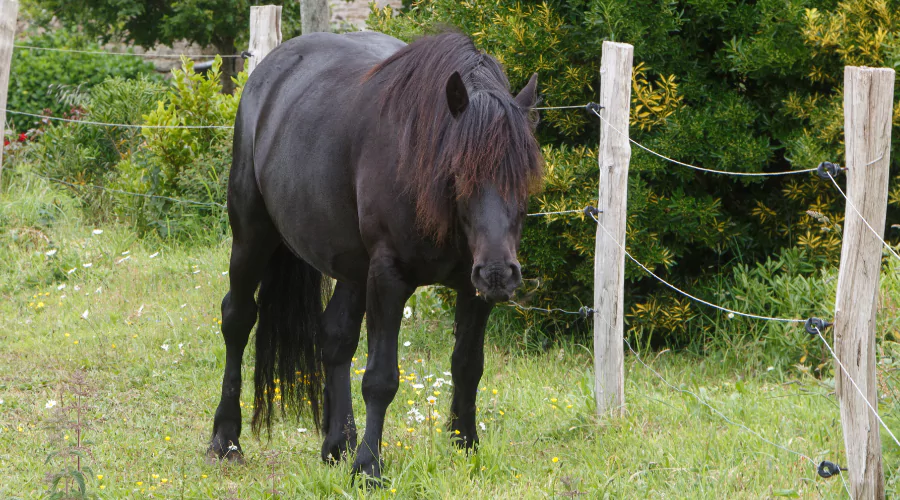
Merens Horse
The Merens Horse, or Ariégeois, is a mountain breed notable for its robust frame and black coat. Originating from the Pyrenees, these horses are recognized for their ability to cross rough terrains, making them great trail horses.
The Merens Horse, also known as the Ariégeois, has a lineage profoundly entrenched in the Pyrenean mountains of southern France. This old species, prominent in the high-altitude areas surrounding the Medieval city of Mirepoix, is renowned for its flexibility and inherent capacity to adapt to the harsh, mountainous environment to which it is native. Their strong frame, frequently totally black or dark brown, is complimented with a robust character and a calm demeanor, giving the Merens a perfect mount for navigating steep and rocky roads.
Historically, the Merens Horse has been a vital element of local life in the Pyrenees, utilized for agricultural labor, as pack animals, and for transportation over the hard terrain. The breed’s persistent stamina and sure-footedness make it especially well-suited for endurance riding, and nowadays, they are commonly sighted in competitive trail riding competitions. Despite their strong relationship with the mountains, these horses demonstrate remarkable agility and lightness of foot, showcasing elegance in manege exercises and showing alike.
Conservation and promotion of the Merens Horse have been a priority for breeding groups, emphasizing keeping their natural features and pure ancestry. These beautiful creatures connect to the pastoral traditions of the Pyrenees and continue to grab the hearts of equestrians and horse enthusiasts throughout the globe.
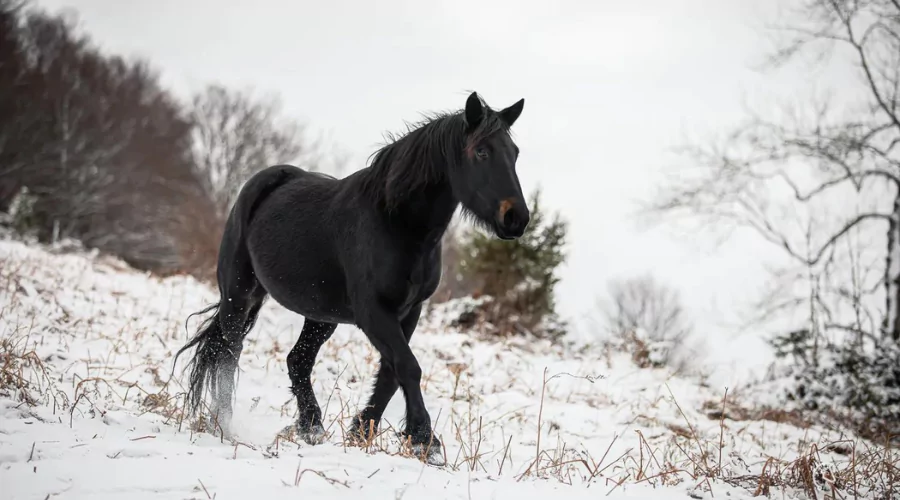
Castillon
The lesser-known Castillon Horse is endemic to the Pyrenean foothills. These horses are distinguished by their durability and are generally employed for riding and light draft labor. The breed is part of conservation efforts because of its diminishing number.
With its origins in the green foothills of the Pyrenees, the Castillon Horse is a breed that displays tenacity and flexibility from its mountain history. Endearingly recognized for their strong health and modest stature, these equines have a peaceful attitude and a brave heart, making them appropriate for rookie and expert riders. Their muscular physique and intrinsic power underline their aptitude for light draft work, but they move with noticeable ease and finesse, making them a delight to ride.
They are often seen wearing coats in rich tones of bay and chestnut, however variances in coloration do occur. Castillon Horses offer a superb example of lasting rustic elegance, symbolizing the area’s ongoing heritage of close human-equine interaction. Despite their numerous virtues, these horses stand the possibility of vanishing as their numbers dwindle with the growth of mechanized farming and changing rural economics. To address this, local enthusiasts and breed preservationists are committing efforts towards promoting the Castillon Horse to preserve their population and bring attention to their role as a living icon of regional identity and culture.
Preserving France’s Equine Legacy
As we reflect on the fascinating and diverse array of equine breeds that are native to France, from the shaggy-coated Poitou Donkey to the steadfast Merens Horse and the adaptable Castillon Horse, it becomes abundantly clear that each breed carries with it a unique story and an intrinsic value to the cultural and natural heritage of the region. These creatures have transcended their function as simply beasts of burden, becoming symbolic images of tradition and an intrinsic part of the rural environment that distinguishes France.
The drive to conserve these breeds is more than an act of conservation—it’s a commitment to safeguarding a living fabric of history for future generations. France’s devotion to conserving these breeds is exhibited via the concentrated efforts of several organizations, breeders, and fans, who realize the beauty and importance beyond their function. Their prolonged survival is a monument to the durability and adaptation of these breeds, as is the human spirit’s capacity for care and respectful guardianship.
Conclusion
In conclusion, when we campaign for the survival and prosperity of the Poitou Donkey, Merens Horse, and Castillon Horse, we commemorate their history and invest in a future where variety in species and legacy is valued. It is a legacy worth sustaining, a heritage that gallops and brays resonantly through the heart of France.
Frequently Asked Questions
What are some of the most significant conservation issues facing France’s native equine breeds?
The most serious challenges are habitat degradation, genetic dilution due to crossbreeding, diminishing population numbers, and a lack of public understanding about the value of these breeds.
How can individuals contribute to preserving breeds like the Poitou Donkey, Merens Horse, and Castillon Horse?
Individuals may assist by supporting local breed groups, engaging in or financing conservation projects, increasing awareness via education, and, in some instances, adopting or sponsoring equines from these breeds.
What roles have the Poitou Donkey and Merens Horse traditionally filled in France?
The Poitou Donkey has traditionally been employed for agricultural work and as a breeding animal. The Merens Horse has been vital for agricultural labor, as pack animals, transportation over harsh terrain, and more recently in competitive trail riding.
Are there any heritage tours or experiences in France that focus on these native equine breeds?
Historical tours and equestrian experiences in France enable tourists to engage with these breeds, learn about their history, and assist in conservation efforts.
What initiatives are in place to ensure the survival of the Castillon Horse?
Initiatives include selective breeding projects, preservation registries, and initiatives to promote their usage in riding, light draft labor, and as a symbol of regional identity to inspire local and worldwide interest.
You May Also Like:
Japanese Horse Breeds: The Legacy of Nobility
Italian Horse Breeds: History, Elegance, and Diversity
Horse Saddle: Types, Parts, and Differences Between English and Western Saddles
Understanding And Managing Horse Hoof Cracks
Essential Oils for Horses
